It’s been a while and although no one’s been complaining, I’ll briefly explain my absence. Been moving around a bit, found what turns out to be my all-time favorite campsite, keeping in mind that we’re going on seven years now of road life, so I’ve seen my share. Not that I couldn’t have written blog posts while finding and being at this new site, but… distractions can come in strange kinds.
Bought an electric bike, a beauty, and went di-rect to the factory in Phoenix to pick it out (a refurb). Been buzzing around the desert landscape on that, my camera gear strapped to my back and to the rear platform. The sumbitch will do nearly 30 on level pavement, half that on these dirt and scree strewn backroads, what with the tires deflated for a smoother ride.
But speaking of beauties, the real distraction has been the near top-of-the-line Canon I splurged on, along with some sleek, fast new lenses. I’ve been thinking about getting back into serious photography and with the 90D I pretty much did so. I now have four Canons, two T6s, a T7, and the new one. With the two intervalometers that attach to the Ts and the built-in one in the 90D (they time the lapse exposures), I’ve been covering the night sky like never before, with two fisheyes taking in the whole of the dome and the 90D targeting the chunk I figure most likely to be fruitful.
The first payoff came on the nights of March 3rd and 4th; other than the campsite shot, all the images on this post are from those nights.
Addendum: Looking at long exposures — and all of these except the campsite one up top are 20 seconds — you have to keep in mind what you are looking at, which, unlike the usual snapshot, is a slice of time, not a moment in time. In the case of night sky photos, motion is what you look for and it comes in lines of light, either solid or broken, the latter representing a blinking light.
All commercial aircraft will display blinking lights (strobes), except when landing, when they light up bright and sold white. Strobes are either red or green although some aircraft will have a white strobe also. Strobes are represented by very short lines, while solid lights are unbroken continuous, the latter being a rarity in conventional aircraft. (According to the law, no aircraft should display a solid white light while in normal flight.)
Military aircrafts (mainly jets of any sort) are legally supposed to be lit conventionally, but who knows. I say this because I’m leaning towards the testing of military aircrafts as my explanation for these images. Thing is, be they military or ‘something else,’ the tracks of these lights represent a bending if not a breaking of the known laws of physics.
The photos you see here do not represent any conventional aircraft. I say this for several reasons, aside from their lighting profiles. (More to come.)
Mainly, keep in mind what you are looking at, i.e., 20 second slices of time.
I’ve caught lights like those in Photo #1 a couple or three times before, as you may recall. What’s odd is… everything about them is odd. The warm, almost orange color, the intensity (they were brighter than they look here) and their shape, the latter indicating that they were almost motionless for the 20 second exposures. I say ‘almost’ because they are slightly oblong, indicating a bit of motion.
For me, Photo #2 is a mind-bender, for the amount of sky the objects cover (especially the longer, middle one) in a mere 20 seconds. One problem in calculating speed is the distance factor; it is very difficult to estimate the distances of night lights. Another issue is angle of motion: The long line in #2 may not (probably is not) at right angles to my line of view. In other words, it may be moving slightly (or a lot) away from or towards the camera view, aside from its up-and-down movement; in these cases (towards or away) the distance traveled would be that much more. (The longer one does appear to have an ‘away’ component, from how the dotted lines get less elongated as they approach the horizon. This ‘moving away’ motion would foreshorten the length of the dots and the down-up component.)
Given that a commercial jet aircraft moving across a 13 inch screen would leave about a 1.5 inch line (with a 20 second exposure), while doing, say, 400 mph, the longer line is an object moving somewhere close to 2,000 mph. This is a conservative estimate, since we are leaving out the toward-away component and the fact that the object enters at the top of frame, meaning we don’t know how far its line would continue if the camera had a wider view up there.
Another factor is fisheye lens distortion. For all the shots shown, the cameras were pointed very much upwards. With the fisheye this means that the ‘top’ of the frame would actually be behind you, if you were looking straight up. In other words, in Photo 2 you’d fall over backwards trying to see where the light line ‘starts.’ This is also a good indication that the object is very far away and not a drone or some such close by. (If it was close by, the line would look… well, very different as it headed for the horizon.)
In fact, in looking at Photo #3 (which follows #2 chronologically), we now can clearly see the object is now headed away from us. And those two bright flashes. What the hell are they?
But my point is that the object has to be doing well over mach 2. I heard no sonic boom.
However, the real indication that something remarkable was going on in the night sky over the Arizona desert on March 3rd and 4th are the many radical direction changes I caught. Look at photos 4,5,6, which are a total of one minute real time (20 seconds each) and estimate the angle of direction change, which I take to be well over 100 degrees (a right angle turn and then some). Although distance (and therefore speed) is problematical, the
object is far enough away to tell us that no conventional aircraft could pull off this turn.
Photos 7 and 8 come even closer to a full 180. Any biological entity in that object would have been turned into mush from the G-forces of that turn, the degree and consistency of the mush depending on distance/speed. But mush nonetheless.
Photo 9 is the best one-image example of an instant right angle turn (90 degrees). No one, nothing could survive those G-forces, and notice there are two objects flying in concert.
The only way these objects could be piloted by living beings is if they had created their own inertial field. This would come with anti-gravity. Anti-gravity research was all in the news in the 1950s, as if they were close. (Note that with ‘The Bell’ the Nazis had apparently succeeded during WW 2.) Then, in 1958 suddenly just the idea, let alone active research, of anti-grav went dark, and hasn’t been heard from since.
Those of you who follow this blog know (or should know) that Elon Musk’s Spacex has been a fraud from day one. Most, if not all, aspects of the Spacex missions are fabrications. How they do some of it (like the live take offs and ridiculous booster landings)… I don’t know. I suspect advanced hologram technology, which has been around for decades. But the How is less important than the What.
Spacex and NASA are there to misdirect us from… whatever is really going on. Based on March 3rd and 4th, plus other images from other nights, plus years of research, I suspect there has been a secret space program since just after World War Two.
But who knows exactly what they images depict. All I know for sure is that they are under intelligent control and are not conventional aircrafts.
Allan
(I have videos of both nights, from which I picked these images. I’ll put them up on Youtube at some point.)
One other reason for my silence: We are truly living in insane times. But for me it’s not the behavior of the PTB, i.e., the all pervasive lies and so forth, that strikes me as insane. It’s the fact that such a small percentage of the rest of humanity understands just how insane our collective situation really is.

In the midst of the flying circus on March 3rd here came another special effect, a rather nice fireball streaking down onto our sorry ass heads. (Actually, it’s headed in the direction of L.A.)
Virtually nothing that these people believe is true. These images are a good example of this.
No one learns anything. No one changes his/her mind about anything. And no one cares.
But you already know this, since you are reading these words.





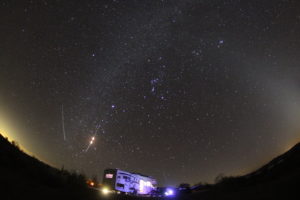

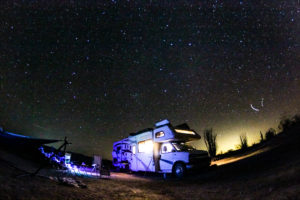

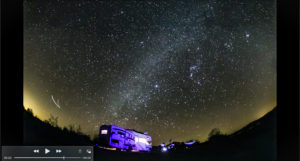
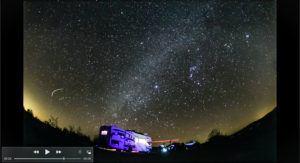
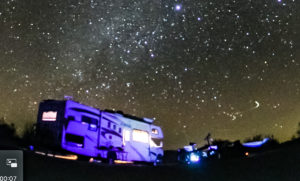
58 comments for “A Flying Circus”